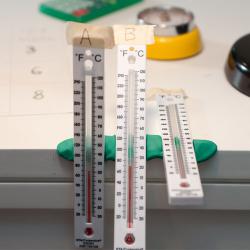Source Institutions
Source Institutions
Add to list Go to activity
Activity link broken? See if it's at the internet archive

In this activity, learners use multiple thermometers, placed at different angles, and a lamp to investigate why some places on Earth's surface are much hotter than others. Learners will create an experiment and record their findings in a data table to discover the importance of the angle of incidence. Step-by-step instructions are included with photos along with safety recommendations. Activity guide includes a "What's going on?" explanation and connections to relevant science concepts like sunlight and the resulting temperature on Earth's surface using helpful diagrams.
- 5 to 10 minutes
- 10 to 30 minutes
- $5 - $10 per group of students
- Ages 8 - adult
- Activity, Experiment/Lab Activity
- English
Quick Guide
Materials List (per group of students)
- three thermometers
- incandescent lightbulb and lamp (40 W preferred)
- clay
- paper and pencil
- watch or timer
- ruler
- masking tape
- calculator
- three thermometers
- incandescent lightbulb and lamp (40 W preferred)
- clay
- paper and pencil
- watch or timer
- ruler
- masking tape
- calculator
Subjects
-
Earth and Space Science
-
Earth Processes
- Weather and Climate
- Earth Structure
- Earth, Moon and Sun
-
Earth Processes
-
Mathematics
-
Data Analysis and Probability
- Data Collection
-
Data Analysis and Probability
-
Physical Sciences
-
Heat and Thermodynamics
- Heat and Temperature
-
Heat and Thermodynamics
Audience
Learning styles supported:
- Involves hands-on or lab activities
Other
This resource is part of:
Access Rights:
- Free access
By:
Source Collection
- DIY Science Apps
Rights:
- , The Regents of the University of California, 2014
Funding Source:
- NASA, NNX10AE05G
